A Machine Learning Approach to Generate High-Resolution Maps of Irrigated Olive Groves
Abstract
1. Introduction
2. Materials and Methods
2.1. Study Area
2.2. Data Collection
2.2.1. Defining Parcel Geometries Using Catastro Data
2.2.2. Filtering Sentinel-2 Images
2.3. Machine Learning: Classification Models
2.3.1. Dynamic Time Warping
2.3.2. The Sakoe–Chiba Band as a Constraint
2.3.3. KNN with DTW
2.3.4. XGBoost
2.3.5. Model Train and Evaluation
3. Results
3.1. NDVI Time Series in Rainfed and Irrigated Olive Groves: Characterization and Comparisons
3.2. Machine Learning for Mapping Irrigated Olive Groves
3.2.1. Classification of Water Management Regimes Using KNN-DTW
3.2.2. Classification of Water Management Regimes Using XGBoost
3.2.3. Do More Historical Data Improve Forecasting? Analyzing the Length of Time Series
3.3. Feature Importance Analysis: Identifying Key Months to Differentiate Irrigated Parcels
4. Discussion
5. Conclusions
Author Contributions
Funding
Data Availability Statement
Conflicts of Interest
References
- Parrilla González, J.A.; Ortega Alonso, D. Sustainable Development Goals in the Andalusian Olive Oil Cooperative Sector: Heritage, Innovation, Gender Perspective and Sustainability. New Medit 2022, 2, 110–115. [Google Scholar] [CrossRef]
- Ropero, R.F.; Rumí, R.; Aguilera, P.A. Bayesian Networks for Evaluating Climate Change Influence in Olive Crops in Andalusia, Spain. Nat. Resour. Model. 2022, 32, e12169. [Google Scholar] [CrossRef]
- Kefi, M.; Pham, T.D.; Kashiwagi, K.; Yoshino, K. Identification of Irrigated Olive Growing Farms Using Remote Sensing Techniques. Euro-Mediterr. J. Environ. Integr. 2016, 1, 3. [Google Scholar] [CrossRef]
- Mattar, C.e.a. The LAB-Net Soil Moisture Network: Application to Thermal Remote Sensing and Surface Energy Balance. Data 2016, 1, 6. [Google Scholar] [CrossRef]
- Intergovernmental Panel on Climate Change (IPCC). Special Report: Global Warming of 1.5 °C; Technical Report; IPCC: Paris, France, 2018. [Google Scholar]
- Boussadia, O.; Omri, A.; Mzid, N. Eco-Physiological Behavior of Five Tunisian Olive Tree Cultivars under Drought Stress. Agronomy 2023, 13, 720. [Google Scholar] [CrossRef]
- Ramadhani, D.e.a. Application of NDVI Sentinel-2Ac Imagery for Agricultural Land Development in Food Buffer Area of New Capital City Indonesia. IOP Conf. Ser. Earth Environ. Sci. 2024, 1290, 012016. [Google Scholar] [CrossRef]
- Hervás-Gámez, C.; Delgado-Ramos, F. Are the Modern Drought Management Plans Modern Enough? The Guadalquivir River Basin Case in Spain. Water 2020, 12, 49. [Google Scholar] [CrossRef]
- Hervás-Gámez, C.; Delgado-Ramos, F. Drought Management Planning Policy: From Europe to Spain. Sustainability 2019, 11, 1862. [Google Scholar] [CrossRef]
- Anderson, L.O.; Malhi, Y.; Aragão, L.E.; Ladle, R.; Arai, E.; Barbier, N.; Phillips, O. Remote Sensing Detection of Droughts in Amazonian Forest Canopies. New Phytol. 2010, 187, 733–750. [Google Scholar] [CrossRef]
- Montero, D.; Aybar, C.; Mahecha, M.D.; Martinuzzi, F.; Söchting, M.; Wieneke, S. A Standardized Catalogue of Spectral Indices to Advance the Use of Remote Sensing in Earth System Research. Sci. Data 2023, 10, 197. [Google Scholar] [CrossRef]
- Li, X.; Jia, H.; Wang, L. Remote Sensing Monitoring of Drought in Southwest China Using Random Forest and eXtreme Gradient Boosting Methods. Remote Sens. 2023, 15, 4840. [Google Scholar] [CrossRef]
- Potgieter, A.B.; Zhao, Y.; Zarco-Tejada, P.J.; Chenu, K.; Zhang, Y.; Porker, K.; Biddulph, B.; Dang, Y.P.; Neale, T.; Roosta, F.; et al. Evolution and Application of Digital Technologies to Predict Crop Type and Crop Phenology in Agriculture. Silico Plants 2021, 3, diab017. [Google Scholar] [CrossRef]
- Guan, X.; Huang, C.; Liu, G.; Meng, X.; Liu, Q. Mapping Rice Cropping Systems in Vietnam Using an NDVI-Based Time-Series Similarity Measurement Based on DTW Distance. Remote Sens. 2016, 8, 19. [Google Scholar] [CrossRef]
- Kunze, L.F.; Amaral, T.; Moraes, L.M.P.; Oliveira, J.J.M.; Junior, A.G.B.; de Sousa, E.P.M.; Cordeiro, R.L.F. Classification Analysis of NDVI Time Series in Metric Spaces for Sugarcane Identification. In Proceedings of the ICEIS 2018 Proceedings, Funchal, Portugal, 21–24 March 2018; pp. 162–169. [Google Scholar] [CrossRef]
- Ketchum, D.; Jencso, K.; Maneta, M.P.; Melton, F.; Jones, M.O.; Huntington, J. IrrMapper: A Machine Learning Approach for High Resolution Mapping of Irrigated Agriculture Across the Western U.S. Remote Sens. 2020, 12, 2328. [Google Scholar] [CrossRef]
- Li, H.; Wan, J.; Liu, S.; Sheng, H.; Xu, M. Wetland Vegetation Classification through Multi-Dimensional Feature Time Series Remote Sensing Images Using Mahalanobis Distance-Based Dynamic Time Warping. Remote Sens. 2022, 14, 501. [Google Scholar] [CrossRef]
- Zhao, F.; Yang, G.; Yang, H.; Zhu, Y.; Meng, Y.; Han, S.; Bu, X. Short and Medium-Term Prediction of Winter Wheat NDVI Based on the DTW-LSTM Combination Method and MODIS Time Series Data. Remote Sens. 2021, 13, 4660. [Google Scholar] [CrossRef]
- Marques, P.; Pádua, L.; Sousa, J.; Fernandes-Silva, A. Advancements in Remote Sensing Imagery Applications for Precision Management in Olive Growing: A Systematic Review. Remote Sens. 2024, 16, 1324. [Google Scholar] [CrossRef]
- Rodríguez, C.; Durán, V.; Francia, J.R.; Martín, F.J.; Moreno, F.; García, I.F. Organic olive farming in Andalusia, Spain. A review. Agron. Sustain. Dev. 2018, 38, 20. [Google Scholar] [CrossRef]
- Guzmán, G.; Boumahdi, A.; Gómez, J. Expansion of olive orchards and their impact on the cultivation and landscape through a case study in the countryside of Cordoba (Spain). Land Use Policy 2022, 116, 106065. [Google Scholar] [CrossRef]
- Martinez, P.; Blanco, M. Sensitivity of Agricultural Development to Water-Related Drivers: The Case of Andalusia (Spain). Water 2019, 11, 1854. [Google Scholar] [CrossRef]
- del Catastro, D.G. Datos Catastrales de España (Archivo Shapefile); Ministerio de Hacienda y Función Pública: Madrid, Spain, 2024. [Google Scholar]
- Gascon, F.; Bouzinac, C.; Thépaut, O.; Jung, M.; Francesconi, B.; Mecklenburg, S. Copernicus Sentinel-2A Calibration and Products Validation Status. Remote Sens. 2017, 9, 584. [Google Scholar] [CrossRef]
- Górecki, T.; Łuczak, M. The Influence of the Sakoe–Chiba Band Size on Time Series Classification. J. Intell. Fuzzy Syst. 2019, 36, 527–539. [Google Scholar] [CrossRef]
- Vasilakos, C.; Tsekouras, G.E.; Kavroudakis, D. LSTM-Based Prediction of Mediterranean Vegetation Dynamics Using NDVI Time-Series Data. Land 2022, 11, 923. [Google Scholar] [CrossRef]
- Herbert, C. Advanced Methods for Earth Observation Data Synergy for Geophysical Parameter R. Doctoral Thesis, Universitat Politècnica de Catalunya, Barcelona, Spain, 2022. [Google Scholar] [CrossRef]
- Leyva, A.; Hidalgo, J.; Vega, V.; Pérez, D.; Hidalgo, J. El Estrés Hídrico y la Formación de Aceite de Oliva; Technical Report; IFAPA, Consejería de Agricultura, Pesca y Desarrollo Rural, Junta de Andalucía: Córdoba, Spain, 2017. [Google Scholar]
- Romi, M.; Hoshika, Y.; Giovannelli, A.; Dias, M.C. Morpho-Physiological Responses of Three Italian Olive Tree (Olea europaea L.) Cultivars to Drought Stress. Horticulturae 2023, 9, 830. [Google Scholar] [CrossRef]
- Orlandi, F.; Garcia-Mozo, H.; Galán, C.; Romano, B.; de la Guardia, C.D.; Ruiz, L.; del Mar Trigo, M.; Dominguez-Vilches, E.; Fornaciari, M. Olive flowering trends in a large Mediterranean area (Italy and Spain). Int. J. Biometeorol. 2010, 54, 151–163. [Google Scholar] [CrossRef]
- Navas-Lopez, J.F.; León, L.; Rapoport, H.F.; Moreno-Alías, I.; Lorite, I.; de la Rosa, R. Genotype, Environment, and Their Interaction Effects on Olive Tree Flowering Phenology and Flower Quality. Euphytica 2019, 215, 184. [Google Scholar] [CrossRef]
- Hueso, A.; Camacho, G.; del Campo, M.G. Spring deficit irrigation promotes significant reduction on vegetative growth, flowering, fruit growth and production in hedgerow olive orchards (cv. Arbequina). Agric. Water Manag. 2021, 248, 106695. [Google Scholar] [CrossRef]
- Fernández, J.E.; Moreno, F.; Girón, I.F. Stomatal Control of Water Use in Olive Trees. Plants Soil 1997, 190, 179–192. [Google Scholar] [CrossRef]
- Marques, P.; Pádua, L.; Sousa, J.J.; Fernandes-Silva, A. Assessing the Water Status and Leaf Pigment Content of Olive Trees: Evaluating the Potential and Feasibility of Unmanned Aerial Vehicle Multispectral and Thermal Data for Estimation Purposes. Remote Sens. 2023, 15, 4777. [Google Scholar] [CrossRef]
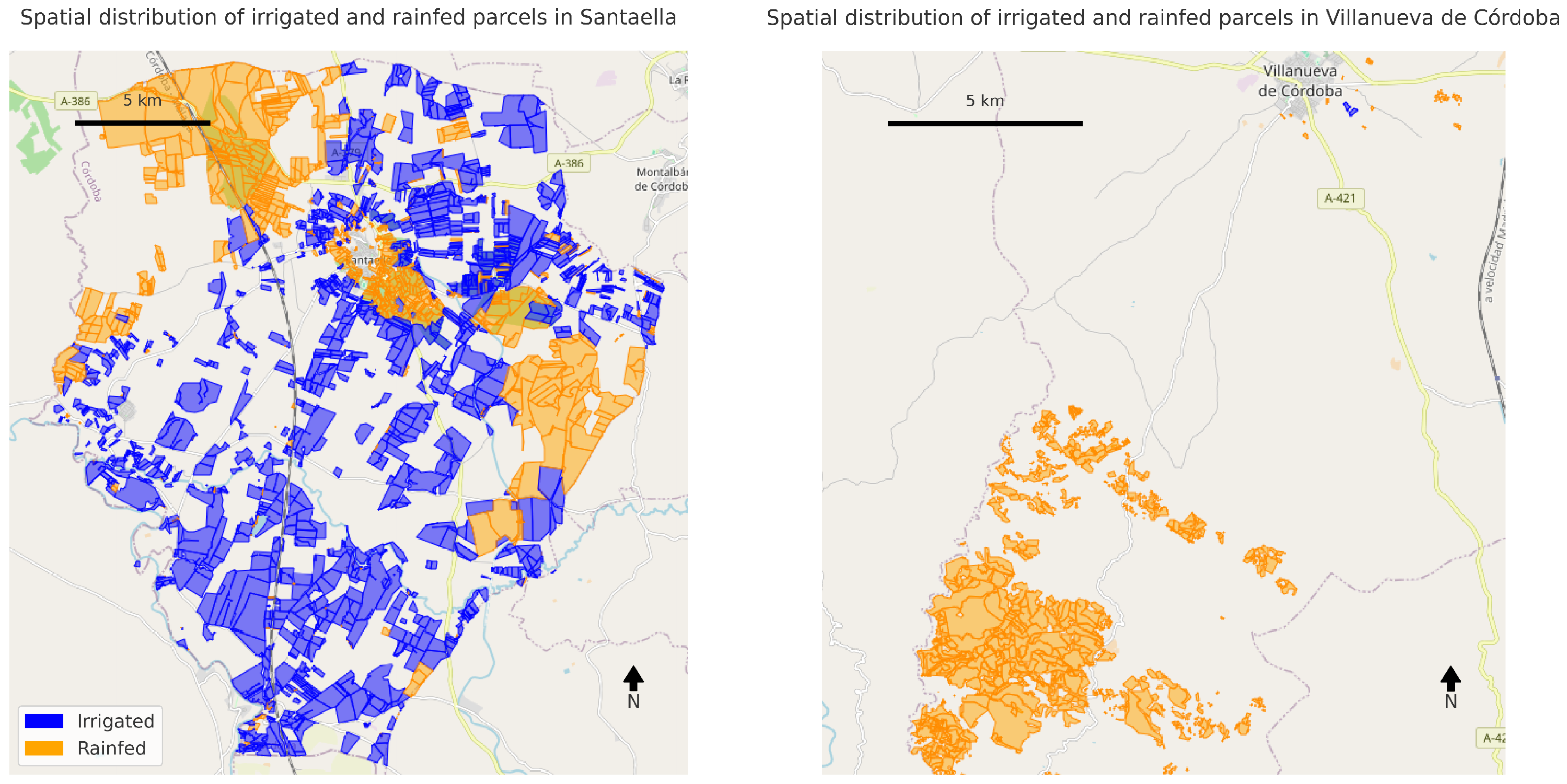
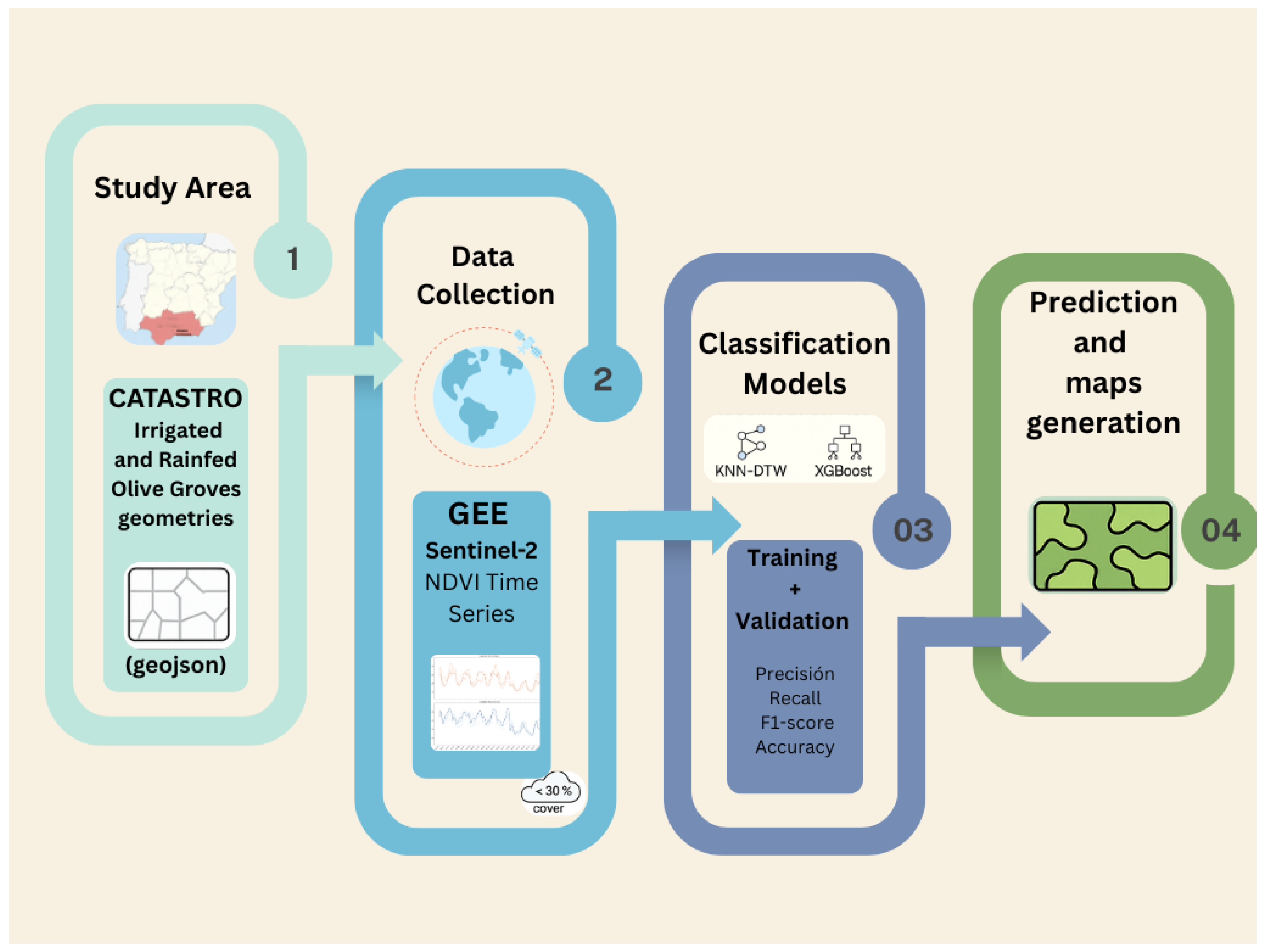
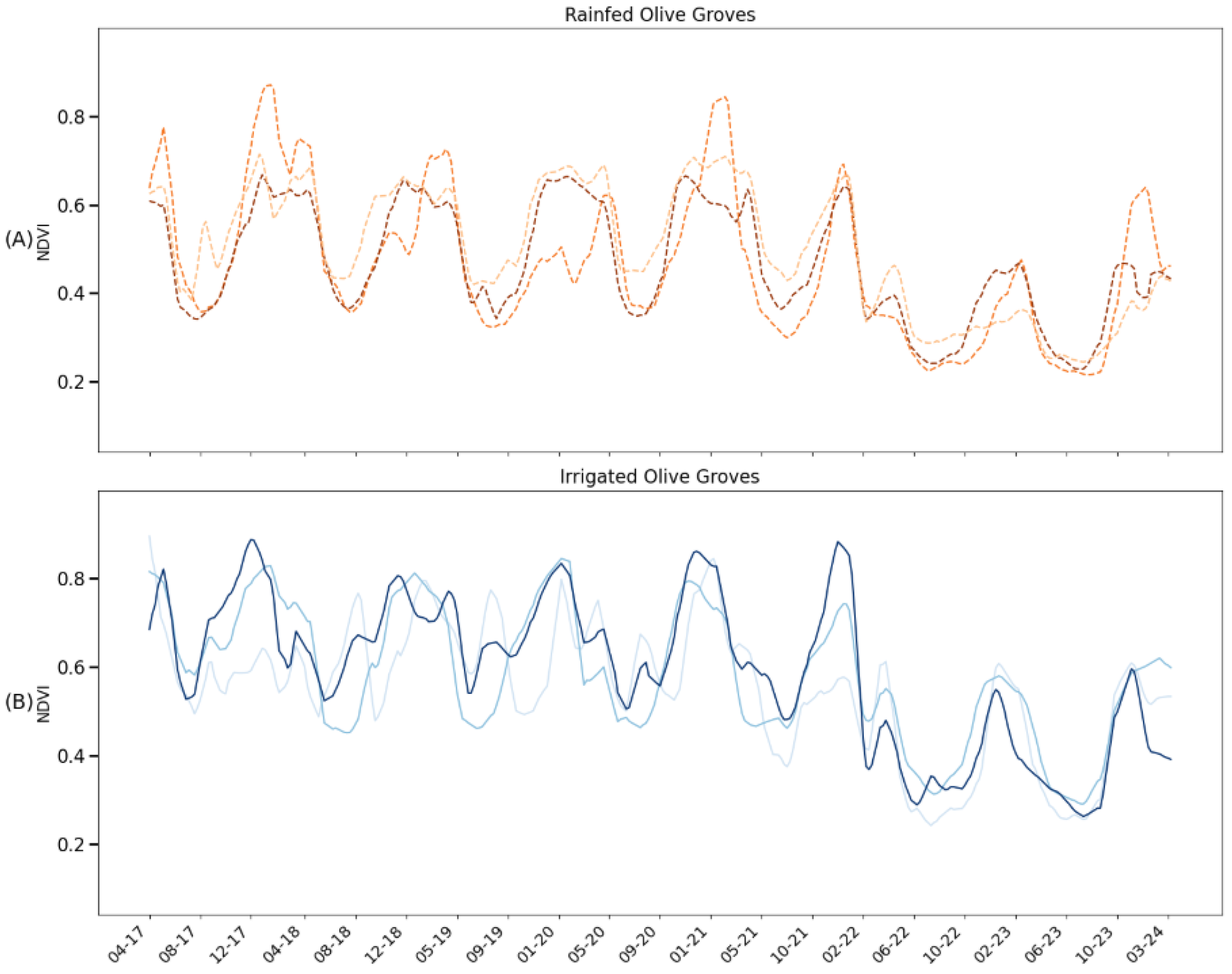
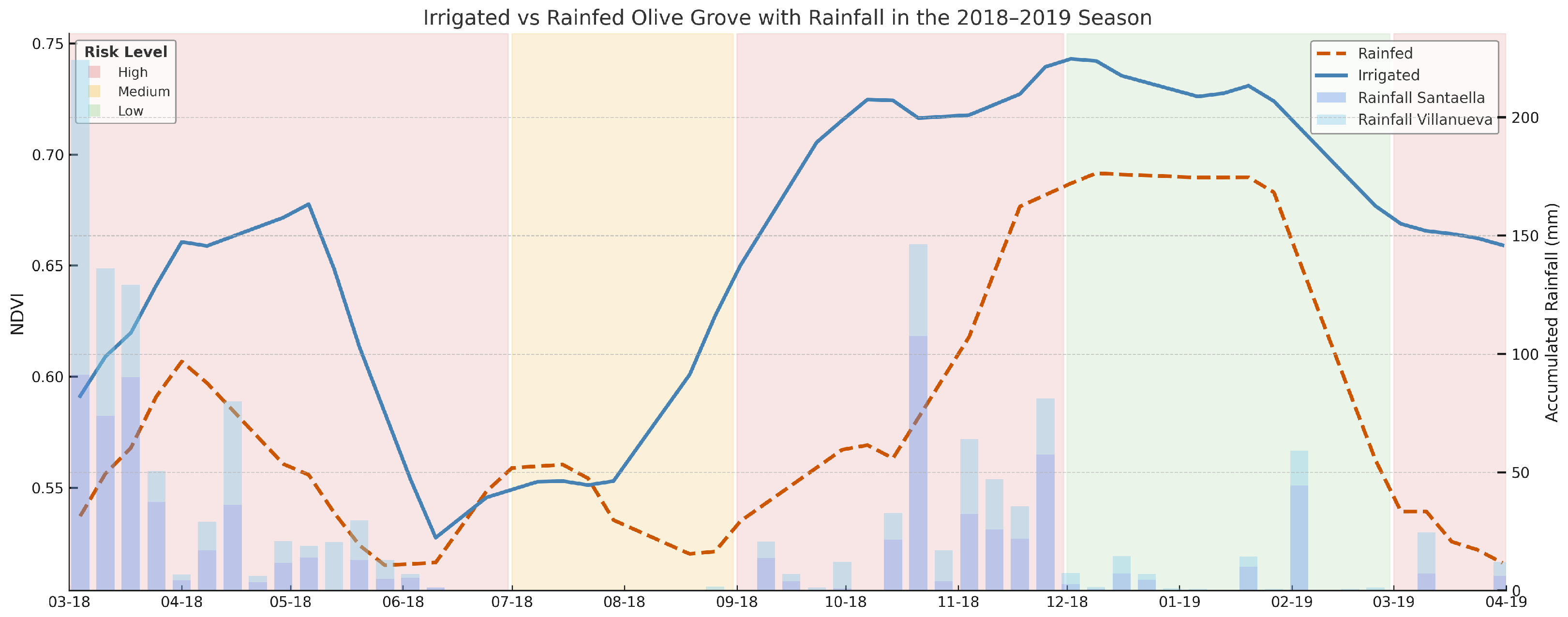
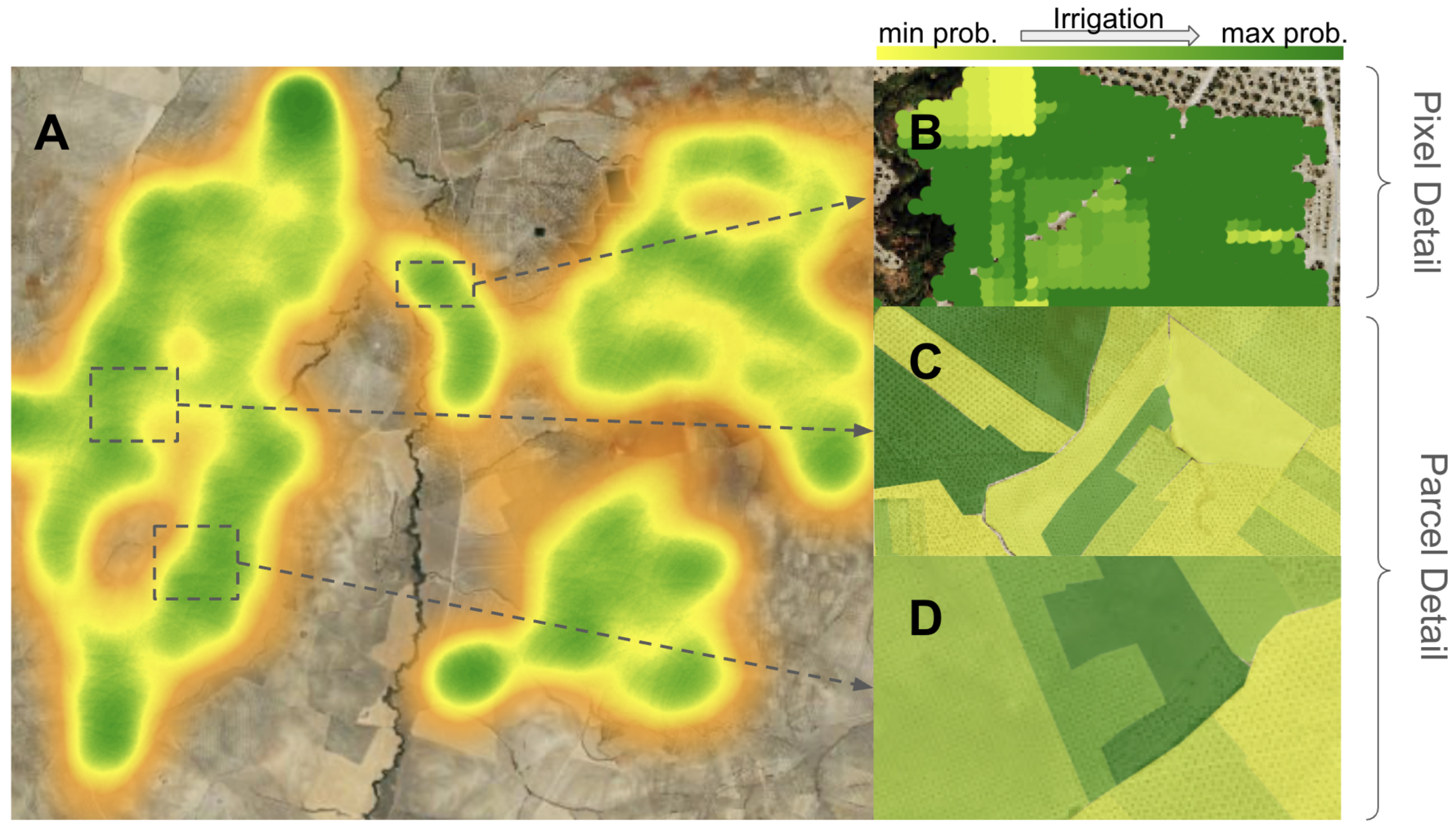

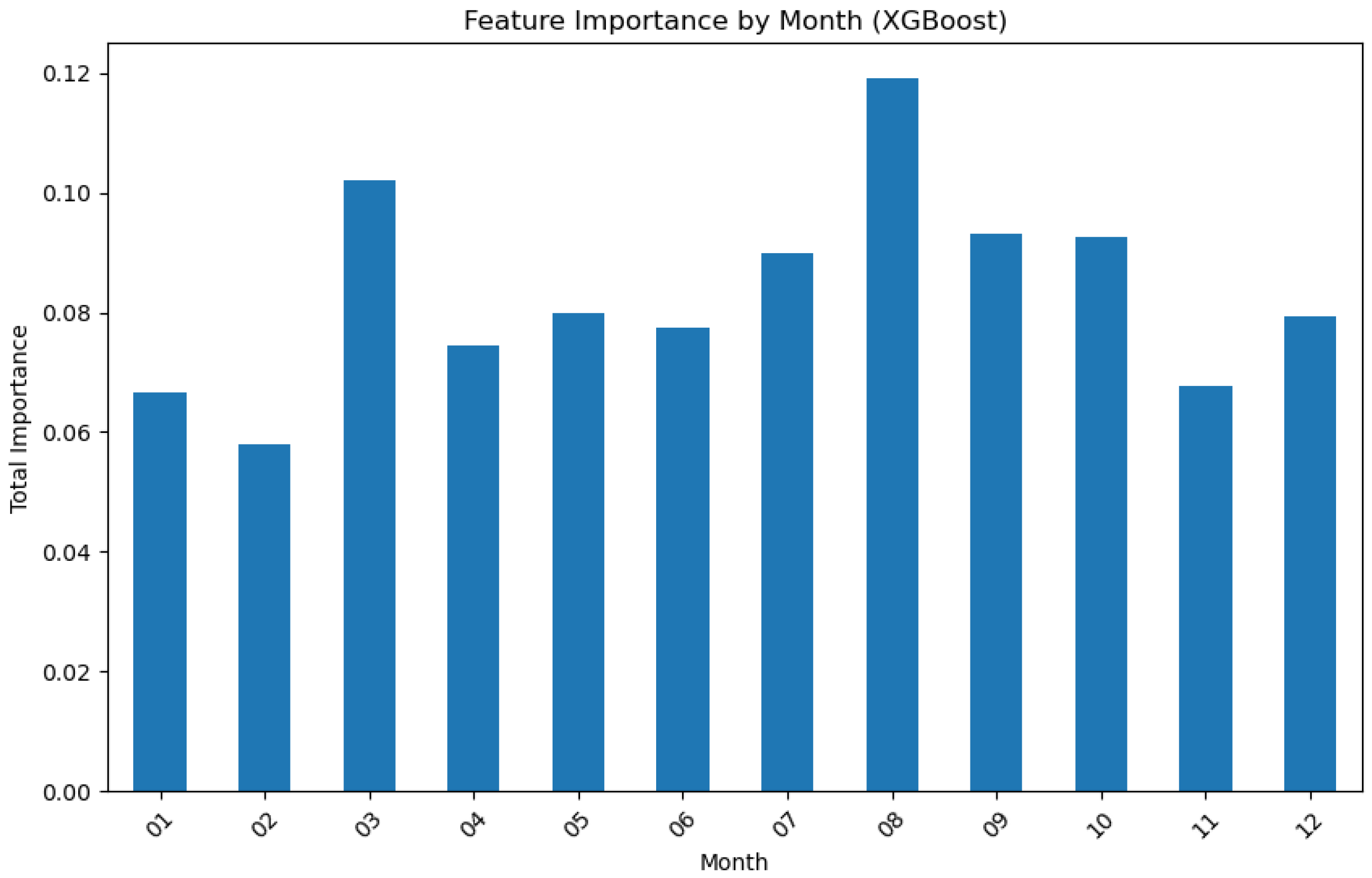
| Municipality | System | Min (ha) | Max (ha) | Mean (ha) | Median (ha) |
|---|---|---|---|---|---|
| Santaella | Rainfed | 0.0019 | 169.64 | 3.34 | 0.67 |
| Santaella | Irrigated | 0.0017 | 81.89 | 3.90 | 1.28 |
| Villanueva de Córdoba | Rainfed | 0.0026 | 107.64 | 2.10 | 0.50 |
| Villanueva de Córdoba | Irrigated | 0.1684 | 2.43 | 1.46 | 1.77 |
| Total | Rainfed | 0.0019 | 169.64 | 2.80 | 0.57 |
| Total | Irrigated | 0.0017 | 81.89 | 3.81 | 1.30 |
| KNN-DTW | KNN-DTW-Sakoe | XGBoost | ||||||||||
|---|---|---|---|---|---|---|---|---|---|---|---|---|
| Accuracy | Precision | Recall | F 1 Score | Accuracy | Precision | Recall | F 1 Score | Accuracy | Precision | Recall | F 1 Score | |
| 7 seasons | 0.72 | 0.73 | 0.72 | 0.72 | 0.76 | 0.76 | 0.76 | 0.76 | 0.80 | 0.81 | 0.80 | 0.80 |
| Seasons | KNN-DTW | KNN-DTW-Sakoe | XGBoost | |||||||||
|---|---|---|---|---|---|---|---|---|---|---|---|---|
| Accuracy | Precision | Recall | F 1 Score | Accuracy | Precision | Recall | F 1 Score | Accuracy | Precision | Recall | F 1 Score | |
| 2017–2018 | 0.70 | 0.70 | 0.70 | 0.70 | 0.70 | 0.70 | 0.70 | 0.69 | 0.72 | 0.72 | 0.72 | 0.72 |
| 2018–2019 | 0.65 | 0.65 | 0.65 | 0.64 | 0.69 | 0.68 | 0.69 | 0.68 | 0.75 | 0.75 | 0.75 | 0.75 |
| 2019–2020 | 0.63 | 0.63 | 0.63 | 0.63 | 0.67 | 0.67 | 0.67 | 0.67 | 0.72 | 0.72 | 0.72 | 0.72 |
| 2020–2021 | 0.63 | 0.63 | 0.63 | 0.63 | 0.68 | 0.68 | 0.68 | 0.68 | 0.72 | 0.72 | 0.72 | 0.72 |
| 2021–2022 | 0.63 | 0.63 | 0.63 | 0.63 | 0.68 | 0.68 | 0.68 | 0.68 | 0.75 | 0.75 | 0.74 | 0.75 |
| 2022–2023 | 0.63 | 0.63 | 0.63 | 0.63 | 0.63 | 0.63 | 0.63 | 0.63 | 0.69 | 0.69 | 0.69 | 0.69 |
| 2023–2024 | 0.62 | 0.60 | 0.60 | 0.60 | 0.65 | 0.65 | 0.65 | 0.65 | 0.71 | 0.71 | 0.71 | 0.71 |
| Grouped Seasons | KNN-DTW with Sakoe–Chiba Band | XGBoost | ||||||
|---|---|---|---|---|---|---|---|---|
| Accuracy | Precision | Recall | F 1 Score | Accuracy | Precision | Recall | F 1 Score | |
| 1 season | 0.67 | 0.67 | 0.67 | 0.67 | 0.72 | 0.72 | 0.72 | 0.72 |
| 2 seasons | 0.70 | 0.70 | 0.70 | 0.70 | 0.76 | 0.76 | 0.76 | 0.76 |
| 3 seasons | 0.71 | 0.72 | 0.71 | 0.71 | 0.79 | 0.79 | 0.79 | 0.79 |
| 4 seasons | 0.73 | 0.74 | 0.73 | 0.72 | 0.79 | 0.79 | 0.79 | 0.79 |
| 5 seasons | 0.73 | 0.74 | 0.73 | 0.73 | 0.80 | 0.81 | 0.80 | 0.80 |
| 6 seasons | 0.76 | 0.77 | 0.76 | 0.75 | 0.80 | 0.81 | 0.80 | 0.80 |
| 7 seasons | 0.76 | 0.76 | 0.76 | 0.76 | 0.80 | 0.81 | 0.80 | 0.80 |
Disclaimer/Publisher’s Note: The statements, opinions and data contained in all publications are solely those of the individual author(s) and contributor(s) and not of MDPI and/or the editor(s). MDPI and/or the editor(s) disclaim responsibility for any injury to people or property resulting from any ideas, methods, instructions or products referred to in the content. |
© 2025 by the authors. Licensee MDPI, Basel, Switzerland. This article is an open access article distributed under the terms and conditions of the Creative Commons Attribution (CC BY) license (https://creativecommons.org/licenses/by/4.0/).
Share and Cite
Gutiérrez-Cabrera, R.; Tarquis, A.M.; Borondo, J. A Machine Learning Approach to Generate High-Resolution Maps of Irrigated Olive Groves. Land 2025, 14, 1001. https://doi.org/10.3390/land14051001
Gutiérrez-Cabrera R, Tarquis AM, Borondo J. A Machine Learning Approach to Generate High-Resolution Maps of Irrigated Olive Groves. Land. 2025; 14(5):1001. https://doi.org/10.3390/land14051001
Chicago/Turabian StyleGutiérrez-Cabrera, Rosa, Ana M. Tarquis, and Javier Borondo. 2025. "A Machine Learning Approach to Generate High-Resolution Maps of Irrigated Olive Groves" Land 14, no. 5: 1001. https://doi.org/10.3390/land14051001
APA StyleGutiérrez-Cabrera, R., Tarquis, A. M., & Borondo, J. (2025). A Machine Learning Approach to Generate High-Resolution Maps of Irrigated Olive Groves. Land, 14(5), 1001. https://doi.org/10.3390/land14051001








